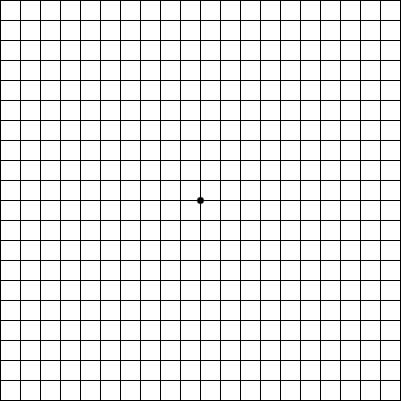Age-related macular degeneration (ARMD) is a chronic condition that causes central vision loss. It affects millions of Americans. In fact, it is a leading cause of blindness in people 50 and older. The older you are, the greater your chance of being affected. Early detection is the key to avoiding vision loss.
Please see Dr. Kalski as soon as possible if you notice any of the following symptoms: • Straight lines or faces appearing wavy. • Doorways seeming crooked. • Objects appearing smaller or farther away.
DRY MACULAR DEGENERATION
Macular degeneration does not cause total blindness, but it worsens your quality of life by blurring or causing a blind spot in your central vision. Clear central vision is necessary for reading, driving, recognizing faces and doing detail work.
Macular degeneration tends to affect adults age 50 and older. Dry macular degeneration, in which tissue deterioration is not accompanied by bleeding, is the most common form of the disease.
WET MACULAR DEGENERATION
Wet macular degeneration occurs when new blood vessels grow and leak fluid underneath the macula, an area of densely packed light-sensitive cells in the central part of the retina. Most cases of wet macular degeneration develop from the dry type of macular degeneration. Early detection and treatment of wet macular degeneration may help reduce the extent of vision loss and in some instances improve vision.
AMSLER GRID
One of the first signs of macular degeneration can be wavy, broken/distorted lines or a blurred or missing area of vision. The Amsler Grid can help you spot these early changes. Early detection of wet ARMD is critical because injections of anti-blood vessel growing medicines or laser treatment, when indicated, is most successful when performed before damage occurs. Since dry ARMD can lead to development of wet ARMD, most patients should use the Amsler Grid. You should use this test daily if you have ARMD.
HOW TO USE THE AMSLER GRID
- Wear your reading glasses if you normally use them, and sit about 14-16 inches away from the screen.
- Check one eye at a time and focus on the dark dot in the center of the grid.
- While looking at this dot, you still should be aware of the lines of the grid. If you notice any blurred, wavy or missing lines, contact Dr. Kalski as soon as possible.
- The test should be performed at least twice per week, but preferably daily.



